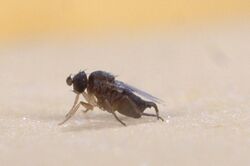Biology:Pseudacteon
| Pseudacteon | |
|---|---|

| |
| Scientific classification | |
| Domain: | Eukaryota |
| Kingdom: | Animalia |
| Phylum: | Arthropoda |
| Class: | Insecta |
| Order: | Diptera |
| Family: | Phoridae |
| Subfamily: | Metopininae |
| Genus: | Pseudacteon Coquillett, 1907[1] |
Pseudacteon is a genus of flies in the family Phoridae. There are over 70 described species of Pseudacteon fly. They are also known as ant-decapitating flies due to their parasitic larval stage. An egg is injected by the female fly into the shoulder joint of an ant worker. Soon after, the egg undergoes rapid inflation as it appears to absorb ant hemolymph. This first instar larva migrates into the ant head and consumes the jaw muscle and other tissues, leaving the mandibles hanging and preparing a future exit space. After about two weeks, the ant worker is termed a "zombie" because the fly larva has effectively taken control. The worker leaves the nest and dies in the leaf litter or in a crack in the soil. As it dies, the ant's head falls off, apparently because the fly larva releases an enzyme that dissolves the membrane attaching the ant's head to its body.[2][3] The fly pupates in the detached head capsule, requiring a further two weeks before emerging through the ant's mouth. In tropical, subtropical areas the flies are active all year round, but in temperate regions they are active during all months except the winter months.[citation needed] Several Pseudacteon species were deliberately introduced to the United States to combat via biological control the invasive fire ant species Solenopsis invicta.[4]
Species
- P. aduncus Borgmeier, 1969
- P. affinis Borgmeier, 1962
- P. antiguensis (Malloch, 1912)
- P. arcuatus Borgmeier, 1969
- P. australis Borgmeier, 1962
- P. bifidus Brown & Morrison, 1999
- P. bispinosus Borgmeier & Prado, 1975
- P. borgmeieri Schmitz, 1923
- P. borgmeieri Schmitz, 1923
- P. botulpalpatus Disney & Mikhailovskaya, 2000
- P. brevicauda Schmitz, 1925
- P. browni Disney, 1991
- P. bulbosus Brown, Folgarait & Gilbert, 2003
- P. calderensis Calcaterra, 2007
- P. californiensis Disney, 1982
- P. caudalis Borgmeier, 1923
- P. claridgei Disney, 2000
- P. comatus Borgmeier, 1925
- P. conicornis Borgmeier, 1962
- P. convexicauda Borgmeier, 1962
- P. crawfordi Coquillett, 1907
- P. crinifer Beyer, 1966
- P. cultellatus Borgmeier, 1925
- P. curriei (Malloch, 1912)
- P. curvatus Borgmeier, 1925
- P. dentiger Borgmeier, 1962
- P. disneyi Pesquero, 2000
- P. dorymyrmecis Borgmeier, 1925
- P. fennicus Schmitz, 1927
- P. formicarum (Verrall, 1877)
- P. fowleri Pesquero, 2000
- P. furvicolor (Beyer, 1959)
- P. genebrae Mattos & Orr, 2002
- P. grandis Greene, 1940
- P. hexasetalis Liu & Cai, 2013
- P. javensis (Brues, 1915)
- P. lenkoi Borgmeier & Prado, 1975
- P. litoralis Borgmeier, 1925
- P. lonicauda Borgmeier & Prado, 1975
- P. lontrae Mattos & Orr, 2002
- P. lundbecki Schmitz, 1924
- P. lusitanus Schmitz, 1938
- P. nocens Borgmeier, 1926
- P. nudicornis Borgmeier, 1925
- P. obtusatus Liu & Cai, 2013
- P. obtusus Borgmeier, 1925
- P. onyx Steyskal, 1944
- P. palpatus Schmitz, 1938
- P. pradei Borgmeier, 1925
- P. pullum Mikhailovskaya, 1995
- P. pusillus Borgmeier, 1938
- P. quadrisetalis Liu & Cai, 2013
- P. rudisetosus Disney & Mikhailovskaya, 2000
- P. setipalpatus Disney & Mikhailovskaya, 2000
- P. setosus Disney & Mikhailovskaya, 2000
- P. simplex Borgmeier, 1969
- P. solenopsidis (Schmitz, 1914)
- P. spatulata (Malloch, 1912)
- P. tricuspis Borgmeier, 1925
- P. tubiceroides Disney, 2000
- P. wasmanni (Schmitz, 1914)
References
- ↑ Coquillett, D.W. (1907). "A new phorid genus with horny ovipositor". The Canadian Entomologist 39 (6): 207–208. doi:10.4039/Ent39207-6. https://zenodo.org/record/1572524.
- ↑ Hanna, Bill (May 12, 2009). "Parasitic flies turn fire ants into zombies". Fort Worth Star-Telegram. Archived from the original on May 22, 2009. https://web.archive.org/web/20090522005217/http://news.yahoo.com/s/mcclatchy/20090512/sc_mcclatchy/3231765. Retrieved 2009-05-14.
- ↑ "New weapon turns fire ants into headless zombies". San Francisco Chronicle. May 13, 2009. Archived from the original on May 16, 2009. https://web.archive.org/web/20090516023741/http://www.sfgate.com/cgi-bin/article.cgi?f=%2Fn%2Fa%2F2009%2F05%2F13%2Fnational%2Fa062256D48.DTL. Retrieved May 13, 2009.
- ↑ Folgarait, Patricia; Plowes, Robert; Gomila, Carolina; Gilbert, Lawrence (March 2020). "1Laboratorio de Hormigas, Departamento de Ciencia y Tecnología, Universidad Nacional de Quilmes, Bernal, 1876, Buenos Aires, Argentina; 2Brackenridge Field Laboratory, University of Texas, 2907 Lake Austin Boulevard, Austin, Texas 78703, USA; *Corresponding author; 2020 — Florida Entomologist — Volume 103, No. 1 9A small parasitoid of fire ants, Pseudacteon obtusitus(Diptera: Phoridae): native range ecology and laboratory rearing". Florida Entomology 103 (1): 10. https://journals.flvc.org/flaent/article/view/107813/120532. Retrieved 3 July 2020.
Wikidata ☰ Q4047517 entry
 |

